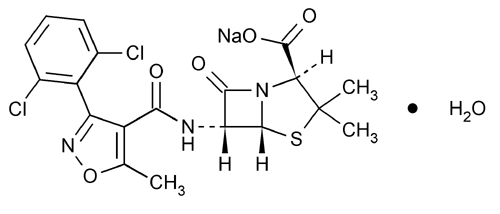Dicloxacillin Sodium
4-Thia-1-azabicyclo[3.2.0]heptane-2-carboxylic acid, 6-[[[3-(2,6-dichlorophenyl)-5-methyl-4-isoxazolyl]carbonyl]amino]-3,3-dimethyl-7-oxo-, monosodium salt, monohydrate, [2S-(2
Monosodium (2S,5R,6R)-6-[3-(2,6-dichlorophenyl)-5-methyl-4-isoxazolecarboxamido]-3,3-dimethyl-7-oxo-4-thia-1-azabicyclo[3.2.0]heptane-2-carboxylate monohydrate
Anhydrous 492.32
» Dicloxacillin Sodium contains the equivalent of not less than 850 µg of dicloxacillin (C19H17Cl2N3O5S) per mg.
Packaging and storage—
Preserve in tight containers.
Identification—
B:
Ignite about 100 mg: a 1 in 20 solution of the residue in acetic acid responds to the tests for Sodium  191
191 .
.
Crystallinity  695
695 :
meets the requirements.
:
meets the requirements.
pH  791
791 :
between 4.5 and 7.5, in a solution containing 10 mg per mL.
:
between 4.5 and 7.5, in a solution containing 10 mg per mL.
Water, Method I  921
921 :
between 3.0% and 5.0%.
:
between 3.0% and 5.0%.
Dimethylaniline  223
223 :
meets the requirement.
:
meets the requirement.
Assay—
Diluent—
Dissolve 5.44 g of monobasic potassium phosphate in water to make 2000 mL of solution, and adjust with 8 N potassium hydroxide to a pH of 5.0 ± 0.1.
Mobile phase—
Prepare a suitable filtered mixture of Diluent and acetonitrile (1500:500). Make adjustments if necessary (see System Suitability under Chromatography  621
621 ). Increasing the acetonitrile concentration decreases the retention time of dicloxacillin.
). Increasing the acetonitrile concentration decreases the retention time of dicloxacillin.
Standard preparation—
Dissolve an accurately weighed quantity of USP Dicloxacillin Sodium RS in Diluent to obtain a solution having a known concentration of about 1.1 mg per mL. [note—Use this Standard preparation promptly, or refrigerate and use on the day prepared.]
Assay preparation—
Transfer about 230 mg of Dicloxacillin Sodium, accurately weighed, to a 200-mL volumetric flask, add Diluent to volume, and mix. Stir with the aid of a magnetic stirrer for 5 minutes to ensure dissolution of the specimen. [note—Use this Assay preparation promptly, or refrigerate and use on the day prepared.]
Chromatographic system
(see Chromatography  621
621 )—The liquid chromatograph is equipped with a 225-nm detector and a 4.6-mm × 25-cm column containing packing L1. The flow rate is about 2 mL per minute. Chromatograph the Standard preparation, and record the responses as directed for Procedure: the capacity factor, k¢, for dicloxacillin is between 4 and 11; the column efficiency is not less than 700 theoretical plates; the tailing factor for the analyte peak is not more than 2.0; and the relative standard deviation for replicate injections is not more than 2.0%.
)—The liquid chromatograph is equipped with a 225-nm detector and a 4.6-mm × 25-cm column containing packing L1. The flow rate is about 2 mL per minute. Chromatograph the Standard preparation, and record the responses as directed for Procedure: the capacity factor, k¢, for dicloxacillin is between 4 and 11; the column efficiency is not less than 700 theoretical plates; the tailing factor for the analyte peak is not more than 2.0; and the relative standard deviation for replicate injections is not more than 2.0%.
Procedure—
Separately inject equal volumes (about 10 µL) of the Standard preparation and the Assay preparation into the chromatograph, record the chromatograms, and measure the area responses for the major peaks. Calculate the quantity, in µg, of dicloxacillin (C19H17Cl2N3O5S) in each mg of the Dicloxacillin Sodium taken by the formula:
200(CE / W)(rU / rS)
in which C is the concentration, in mg per mL, of USP Dicloxacillin Sodium RS in the Standard preparation; E is the dicloxacillin equivalent, in µg per mg, of USP Dicloxacillin Sodium RS; W is the weight, in mg, of the portion of Dicloxacillin Sodium taken; and rU and rS are the dicloxacillin peak area responses obtained from the Assay preparation and the Standard preparation, respectively.
Auxiliary Information—
Please check for your question in the FAQs before contacting USP.
Chromatographic Column—
| Topic/Question | Contact | Expert Committee |
| Monograph | Ahalya Wise, M.S.
Scientist 1-301-816-8161 |
(MDANT05) Monograph Development-Antibiotics |
| Reference Standards | Lili Wang, Technical Services Scientist 1-301-816-8129 RSTech@usp.org |
USP32–NF27 Page 2127
Chromatographic columns text is not derived from, and not part of, USP 32 or NF 27.
